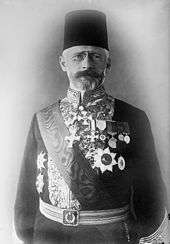Heinrich August Meissner

Heinrich August Meissner (German: Heinrich August Meißner, January 3, 1862 – January 14, 1940) was a German engineer who was largely responsible for the railway network in the Ottoman Empire, and later helped manage the network in Turkey. He attained the title of pasha in the empire.
Personal life
Meissner was born in Leipzig in 1862. He studied at the Dresden University of Technology. Interested in the public works being planned in Turkey, he studied the Turkish language, and at the age of 24 moved to the Ottoman Empire.[1][2][3] Meissner died in 1940 in Istanbul.[4]
Railway work
Early works
Starting in 1886, Meissner served in a number of important posts related to civil engineering in the Ottoman Empire. He worked on railways in southern Bulgaria, Macedonia, Antalya and Thrace.[2]
Hejaz and Baghdad railways
Meissner was invited to manage the construction of the Hejaz Railway, the largest public works undertaking in the empire. In the eight years from 1900 to 1908, he was able to build the main section, from Damascus to Medina, including the Jezreel Valley railway. In 1904 he received the title of pasha from the Sultan for his work on the railway, stretching only from Damascus to Ma'an at the time.[2] After the Young Turk Revolution of 1908, the Hejaz Railway project was abandoned, and Meissner moved on to the Baghdad Railway project, funded by the German Empire.[5]
In 1910 Meissner was chosen to manage the Aleppo section of the railway, and later moved on to Mesopotamia (modern-day Iraq) for the Baghdad section.[5]
World War I
In World War I, Meissner served under Djemal Pasha, who was his personal friend from their time in Mesopotamia. He helped build the Ottoman military railway system in Palestine in the war. After the war he went back to Germany.[4]
After the war
In 1924 Meissner was invited by Mustafa Kemal Atatürk to continue his railway work. He oversaw the reconstruction and maintenance of many railway lines in Turkey and later taught at the Istanbul Technical University.[4]
References
- ↑ Naor (2009), p. 14
- 1 2 3 Fik (1979), p. 102
- ↑ "Meißner, Heinrich August". Neue Deutsche Biographie (in German). Retrieved August 6, 2016.
- 1 2 3 Fik (1979), p. 104
- 1 2 Fik (1979), p. 103
Bibliography
- Naor, Mordecai (2009). The Valley Railway Line Revisited (in Hebrew). Yehuda Dekel Library – Israel Society for the Preservation of Heritage Sites. Retrieved August 6, 2016.
- Fik, Pinhas (January 1979). "Meissner Pasha: The Railway Pioneer in the Land of Israel and its Neighbors" (PDF). Cathedra (in Hebrew). Yad Ben Zvi (Issue 10). Retrieved August 6, 2016.